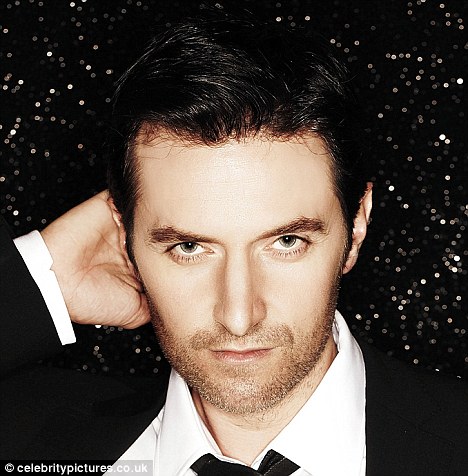A less than peaceful Sabbath with The Crucible on screen and Richard Armitage
[I know some fans now become upset when others refer to The Crucible on Screen. I sympathize with everyone who has not yet been able to see the production in any form. I offer those people my peace, however, since I do have legal access to the play and I’ve decided I am going to write about it. I continue to believe that the piece will become available to general subscribers to Digital Theatre, once the company has exhausted the film’s cinema and institutional subscription potential. As far as I have been able to ascertain, rumors to the contrary are as of yet suppositions not based on any evidence beyond the ongoing apparent delay of the North American release as a digital download.]
[Edited for typos.]
***
Tonight, I took the opportunity to watch the production from my institution’s library subscription to Digital Theatre Plus. Worked a charm, streaming delivered smoothly, and while the video quality itself wasn’t amazingly high resolution, it was more than satisfactory. I’m going to drop some initial impressions here, though I’ll have more to say eventually.
@robertdelamere @DigitalTheatre @CinemaLiveInfo @yfarber NYC screening of #thecrucibleonscreen ‘you captured it’
— Richard Armitage (@RCArmitage) February 3, 2015
Now having seen it myself, I find that assertion tremendously interesting. I’m not speculating on what Armitage meant, but rather using the idea of “capture” to talk about the film.
To me, anyway, the onscreen version is a thing fundamentally and decisively different from the stage version. Naturally, live theater and video are two different things. I don’t think the difference necessarily disadvantages our perception of the screen version — just that the two phenomena are only deceptively similar manifestations of the same event. In that sense, the screen version certainly “captured” some aspects of the play, but it comes by no means even close to reproducing the event as I experienced it. The scenes cut into the video version were played about a week after I left London, and Yael Farber came back to tweak the production, and I found some obvious changes between what I saw and what one sees on screen.
The energy of the work is noticeably different — though it was a shouty play when I saw it and it is shoutier here. Although the run time is back up to 3:19 (when I saw it, it was more like 3:05), it seems to move more quickly, primarily because of the editing, which, although very traditional in style, focuses our attention very quickly on the most important thing happening on the stage. On the one hand, one of the more valuable aspects of the production in the round with the audience so close is largely lost in the video: my awareness that everything I was seeing was inevitably, almost disturbingly, perspectival, the interpretive problem I couldn’t avoid that despite the fact that I could have been catching spit from some of the actors, I was only ever getting a section of the “truth” of what was happening right before my very eyes. On the other hand, however, the screen version, with its “omniscient camera” editing style, probably gives us a clearer idea of what Yael Farber, or perhaps Yael Farber and Robert Delamere together, wanted to say.
The latter lends itself better to thought about the play, for me. I brought a lot of stuff with me to this play, as this blog has made clear, but the sheer fact of Armitage’s physical presence overwhelmed a lot of that when I saw it live. From that perspective, the astounding personal energy of Richard Armitage on the Old Vic stage — while there’s a palimpsest of it here — is simply not fully captured by the screen version. I concede, however, that this is probably one of the most “physically angry” roles that fans have seen him up to this point that didn’t involve the active employment of a weapon, so those who didn’t see it on stage may be somewhat taken aback by just how “unleashed” Armitage can be as an actor. Although he never shoots a gun, Armitage’s Proctor has a subtle malevolent vibe (first seen when he threatens Mr. Putnam) that explodes again and again. I never believed Armitage’s statement that he could throw a chair until I saw him on stage, and now I very much accept his subsequent assertion that he has has to learn to tone himself down in real life as a physically imposing person. On the other hand, the video version focuses the Armitage fan back on the production of the play as a totality. It was certainly clear in London that it was an ensemble work rather than a leading man play (in contrary to Richard III, for instance), but that becomes even clearer from watching the video version. As a viewer, one simply can’t follow everything Proctor is doing in response to what the character observes, because he is repeatedly cut out of the screen. (The same thing happens, and is a greater loss, to Adrian Schiller as Hale.)
And Armitage? I think the fan who did not see him in The Crucible on stage will probably gain an impression similar to those who did, for this piece reveals like never before in what we have been able to see just how much Armitage has as an actor. His work up until this point has always put him in a context where he was an (at times decisive) piece of the production but the whole thing wasn’t resting on his shoulders. (The way he moves his trapezius in Act Four is unforgettable.) Here he bears a lot more responsibility and not only does he not come up lacking, he delivers in spades. More than that: one has the impression that there are still hidden depths in this man, that the next time he appears on stage, he will have not only different things to show his audiences, but perfected versions of them. However I feel about some aspects of his performance (as I noted in my September review of his performance, he sometimes appears verbally undercommitted in the “louder” scenes of the work, and that is still apparent here), what comes across is the incredible power of his physical presence, his energy, his magnetism, his ability to draw all eyes to him with the shifting of his glance or the position of his hands. We don’t miss words here in the way that we occasionally did in the theater, but if we did, his body would distract us from that. In that sense, the video captures so much of his potential, of this snapshot along his professional journey. In Act Two, in particular, we see the combination of the physical and the tender Armitage in ways that we did not see before London — and getting to see that, again, alone is worth this amazing capture. I’ve never before felt like I really had a sense of what an Armitage character might be like as a husband beyond very brief glimpses — and John Proctor is that character personified. Proctor the husband, Armitage the very masculine man — captured.
Some final random impressions: To me, the reduction of the entrancing scene changes (which are still atmospheric, but simply not as vivid) was a huge loss, but I suspect that will be the case only for viewers who are comparing the screen version to the original. The closeups in the washing scene make both the charms of Armitage’s physique and the larger meaning of why he was shirtless at that moment even more forceful. Anna Madeley in particular gains a lot from the closeup style of editing, as does Natalie Gavin, but Samatha Colley (somewhat like Armitage) lost a bit. The choreography of the “possession” moments of the play was altered and improved so that it didn’t seem quite so much like a dance. The kiss is still fantastic.
I can’t believe I can stream this thing at will IN MY OFFICE. I think I’ll be spending a lot of lunch hours with John Proctor. I can’t wait.




Thanks for sharing your thoughts on this version.
I’m trusting, too, that this will become available to everyone who wants it eventually. I’m patiently waiting my turn.
I’m a little anxious that the level of shouting will jolt me out if the story. I’m hoping to be utterly drawn in.
LikeLike
I think both versions are very tense — both times I honestly felt unable to look away. (the difference was with the screen version that I was able to go to the bathroom and stop the stream while doing so, lol).
LikeLike
Thank you for the analysis between your live and digital experiences. Can I come and hang out in your office for a few hours? I will bring popcorn, candy or beer if desired.
LikeLike
You can, but it sounds like you have found a solution 🙂
LikeLike
I still live in hope that I will be able to see the DT version of the play, thanks to the kind fairy godmother who gifted me with a certificate for it. It doesn’t expire until some time next year–or the year after–so surely they will make it available to us well before that happens, yes?
I very much enjoyed reading your insights. I also think we’ve just seen a fraction of what this very talented and versatile actor is capable of doing. 😀
LikeLike
I’m confident you will be able to.
Really after seeing him on the stage I was totally like, I can see why he saw television as Plan B back in the late 1990s. Why would you do that if you can do this? (I also thought I don’t go to the theater enough.)
LikeLike
You describe it very good, I felt much similar about the differences between live and screen performance. There is one thing I didn’t talk or write about up to now…the very angry scenes. I also thought, having seen it on stage from very close by, that I never wish to stand in front of this man, when he really is angry. … And as I read your post I remembered that I have thought about that once before. I haven’t seen all of Spooks, but in series 8 there is a short scene where Lucas meets his American girlfriend after he found out, that she betrayed him. And he hits her in the face.
[Edited at commentator’s request.]
LikeLike
I think a lot of us ask questions about the source of his apparent capacity to convincingly play theatrical violence.
LikeLiked by 1 person
Yes, I’m sure. I just saw recently, that it is not easy to discuss such topics. He seems to be an ideal person to develop a very own imagination of. And some ladies protect their imagination fiercely. I guess a discussion about that part of his personality would be terrible. Although he talked himself about it and how I found much more open, than about other things.
LikeLike
Thank you,Sevetus 🙂 I’m sure the stage play was way better..and yeah,
the kiss was fantastic sigh I cried like a baby..silently of course 🙂 ( I never cry in public) I bet he can make stage kiss less awkward for any actress..cuz I think it must be his contribusion or.. is it just my wishful thinking? 😀
From my perspective Sarah Niles (she was great as Tituba) William Gaunt(Giles Cory) Ann Firebank( Rebecca Nurse) and “older”assembly of actors were the best.
As to Richard..his voice,his stage presence,his manliness ,his tenderness..everything in spades nothing in moderation;). He gives the impression that he is born to play heroes, kings and…monsters.
LikeLike
It was so different from the other kisses of his we’ve seen.
He is totally larger than life on stage. And he had a great supporting cast this time around — serious theatre professionals.
LikeLike
” larger than life” 🙂 very adequate idiom .
LikeLike
Reblogged this on Just wanna say….
LikeLike
It appears the digital version has the Servetus Seal of Approval (SSA). I am hoping it will be released to us in NA soon; I will be patient though. This latest review of his performance in The Crucible combined with what you shared of the comments in your “Bloody Ice Bucket Challenge” post of RA in Esquire leads me to believe his Dolarhyde performance might be pretty special. And I have the feeling I will be seeing that performance before John Proctor. Patience, patience.
LikeLike
it’s entirely possible, depending on how long Digital Theatre can keep selling cinema tickets 🙂
LikeLike
[…] seeing what Servetus has been up to, it occurred to me that my own, darling Hubby happens to be a faculty member at an educational […]
LikeLike
Thanks for your thoughts, and for the inspiration to check and see if my own educator might have institutional access. Insert Happy Dance =)
“More than that: one has the impression that there are still hidden things in this man, that the next time he appears on stage, he will have not only different things to show his audiences, but perfected versions of them. ” The anticipation for his next stage project is off the charts.
LikeLike
that’s for sure. I wlll never be hesitant about spending the money, assuming I have it, again!
LikeLiked by 1 person
I might hate you just a teensy bit right now. 😉
LikeLike
That, I can live with, and it might be justified. 🙂
LikeLike
[…] Here’s a general review of my first reactions to the screen version. […]
LikeLike
Nipple, nipple, nipple! I’ve been informed that I’m not taking The Crucible on screen seriously enough | Me + Richard Armitage said this on March 21, 2015 at 7:14 pm |
Mr. Armitage has a commanding presence on the screen,I can only imagine what it must have been like live,in the round..As I have become more familiar with his work, it is the one thing I find myself doing every time, “watching” him, I cannot help it..It is only recently that I have “seen” The Hobbit, actually saw what was happening in BOFA , everything around him, other than his presence on that screen..I have watch The Crucible twice, and when he enters, its all him…He draws you in and keeps you focused on him, his physic, his movements, his expressions, his sheer size and persona keeps you zoomed in to him..I gotta say, he was almost scary to watch in some of the Crucible scenes, I can only imagine what Hannible is going to bring….I pray he does NYC theater, I’ll be in the front row,I’m saving for tickets now 🙂
LikeLike
Armitage live was worth every penny.
LikeLike